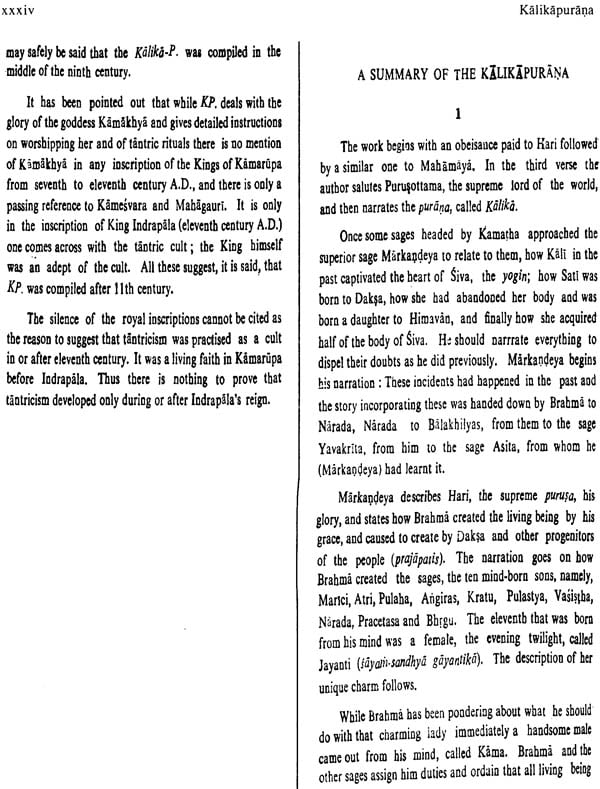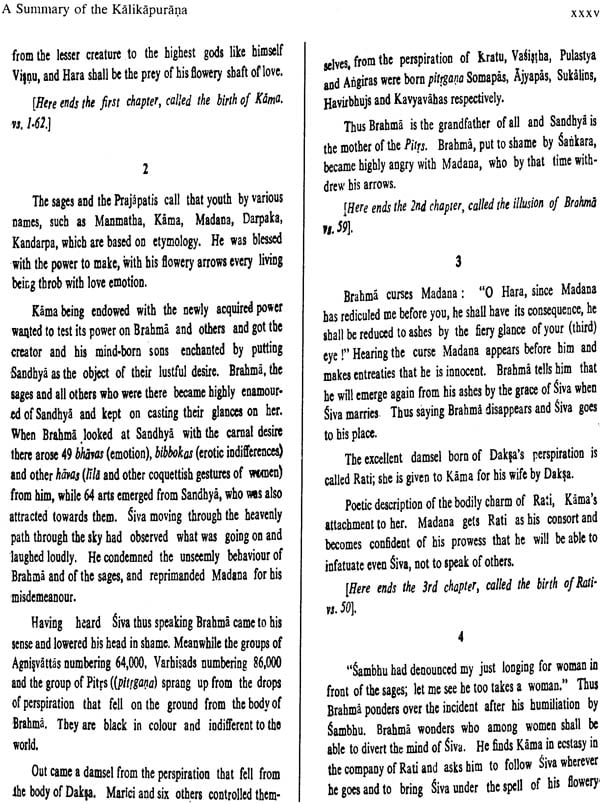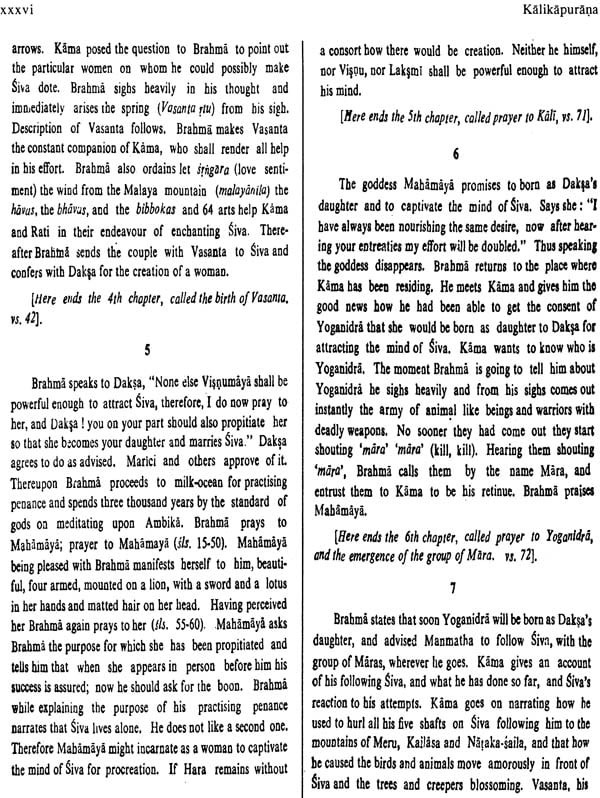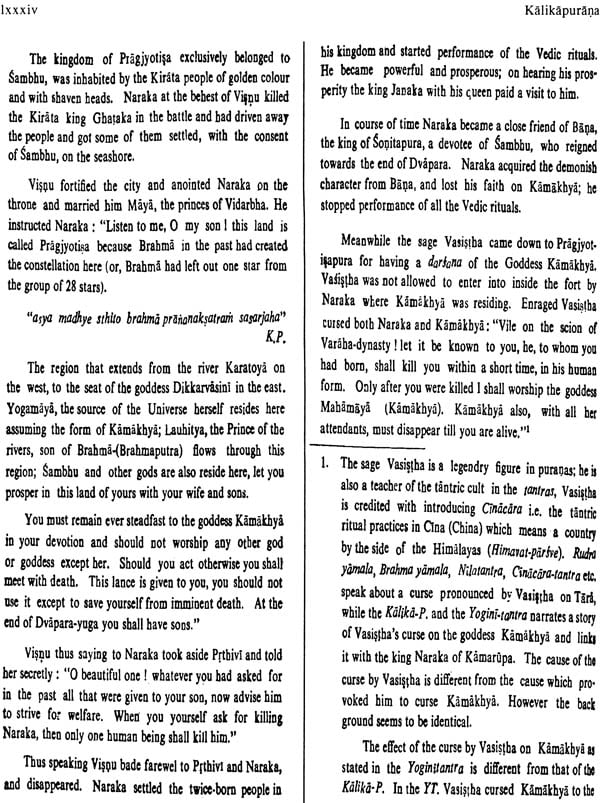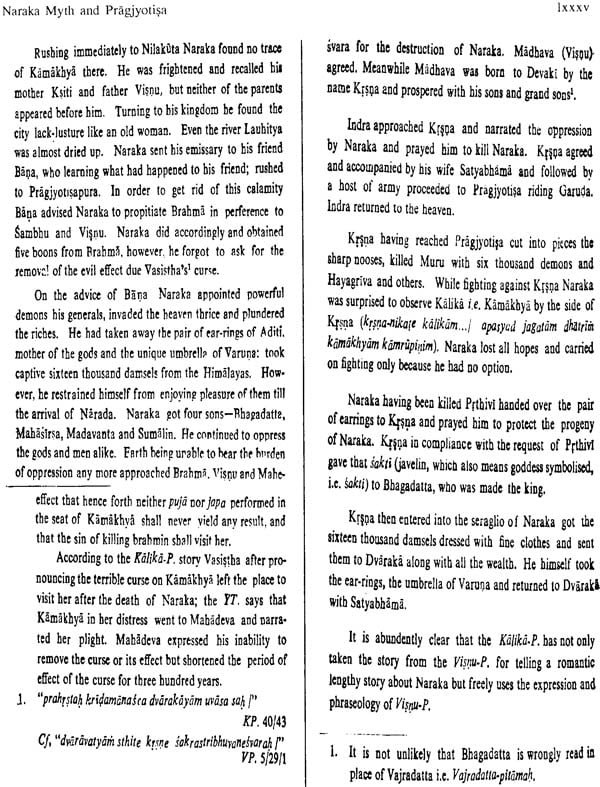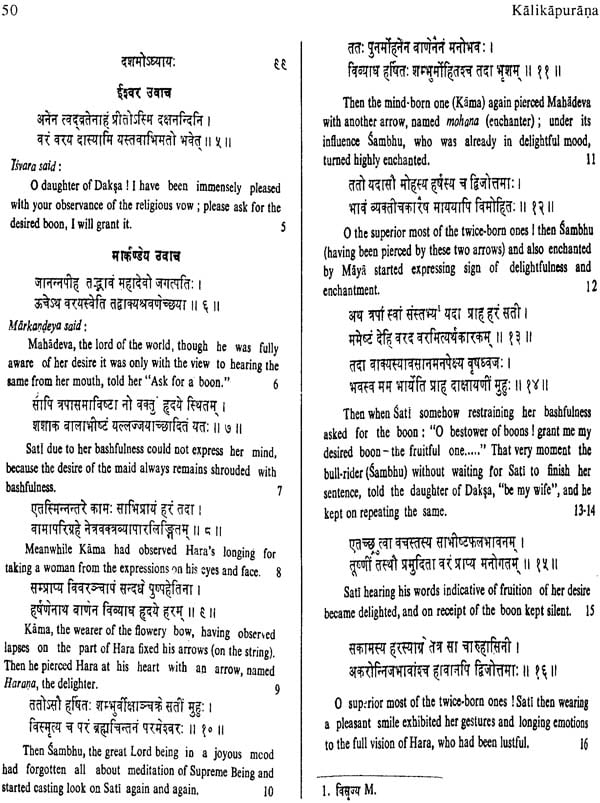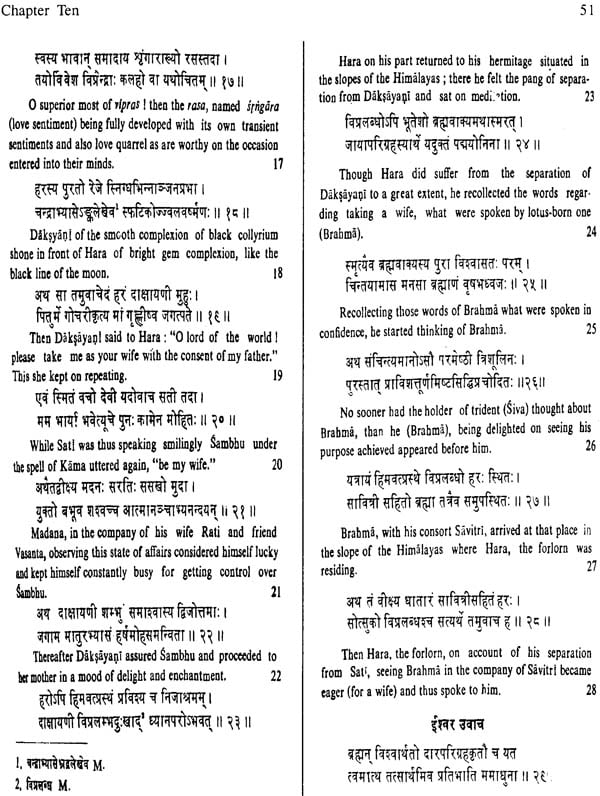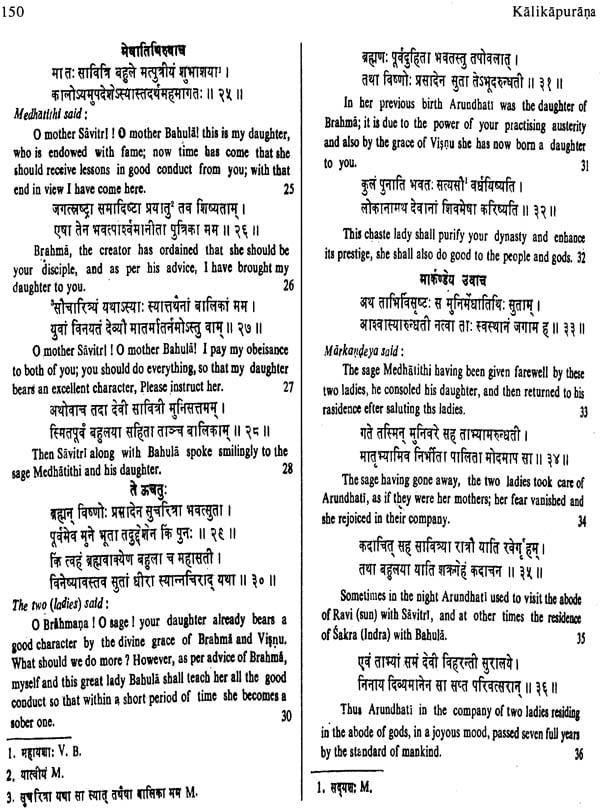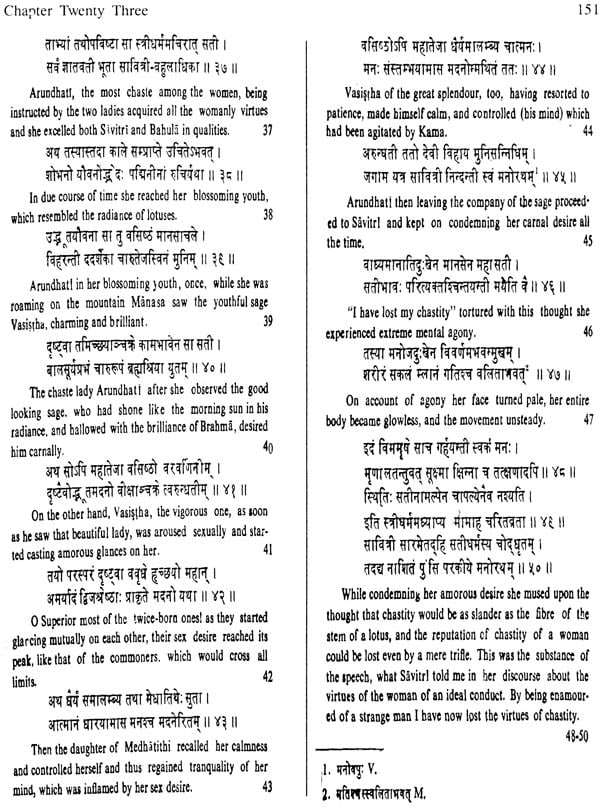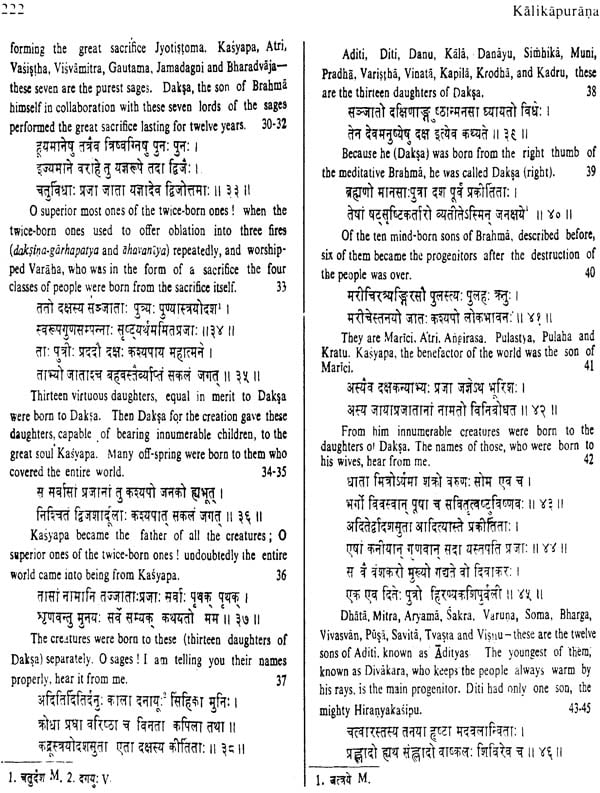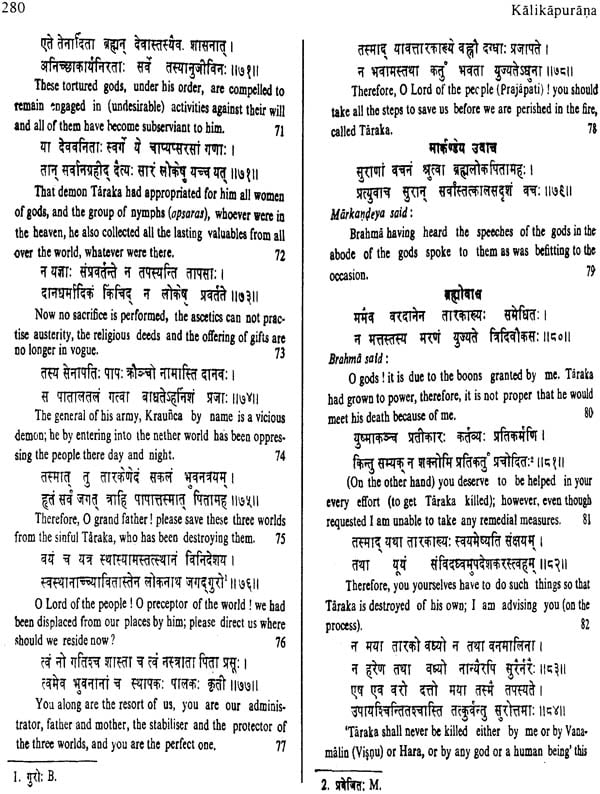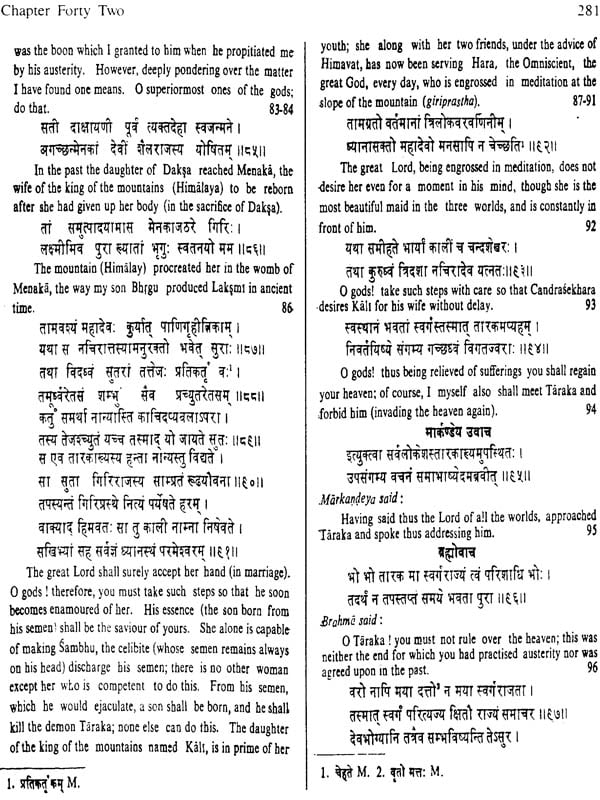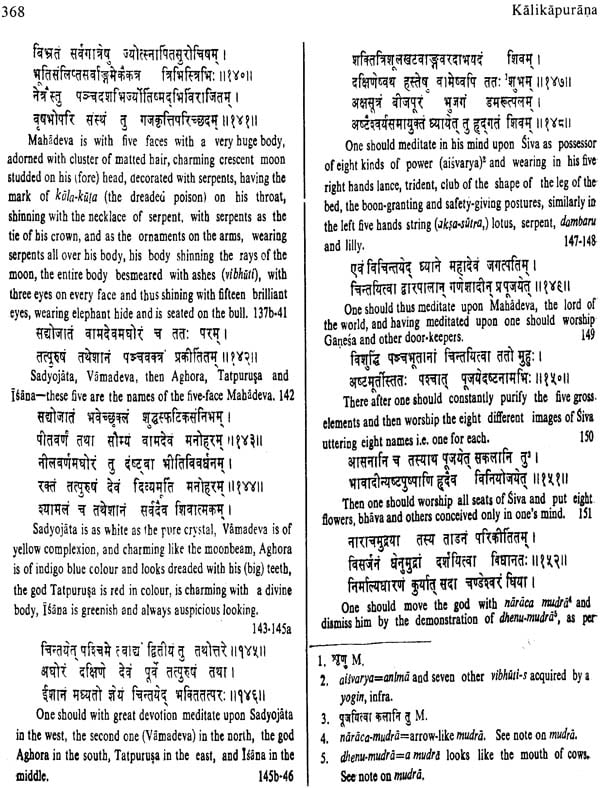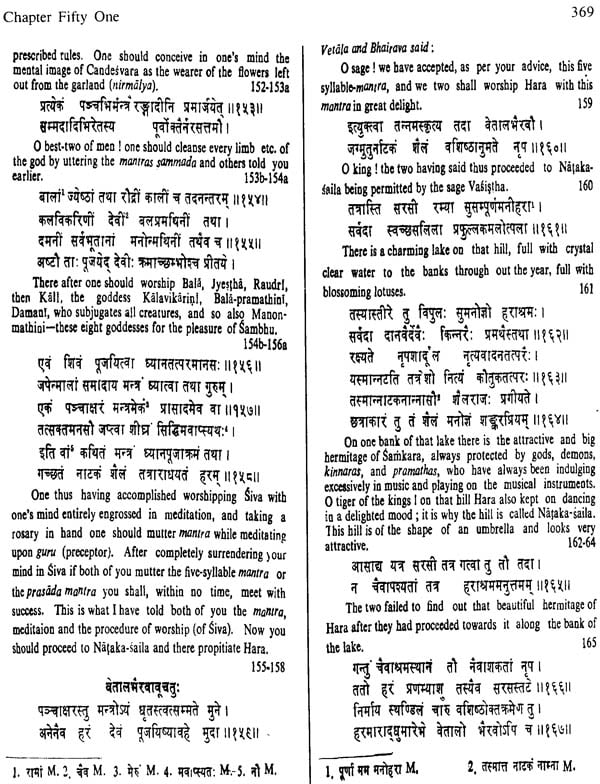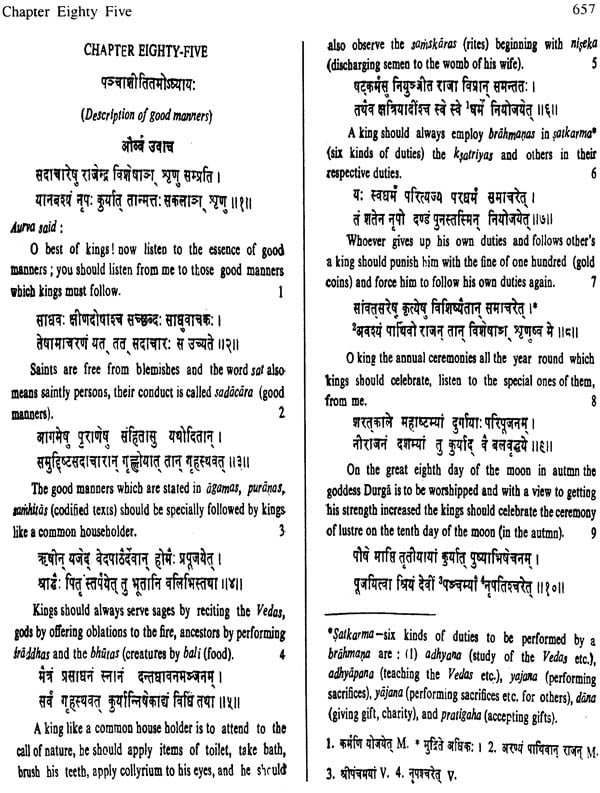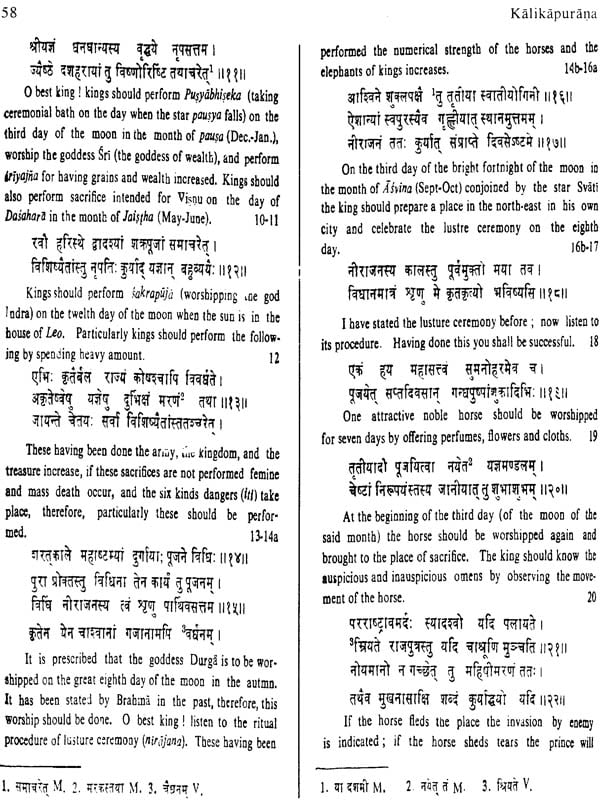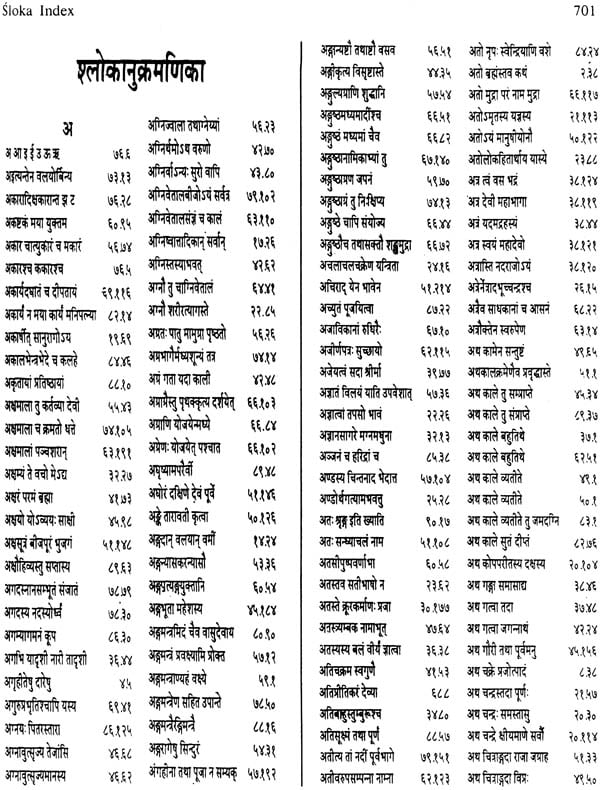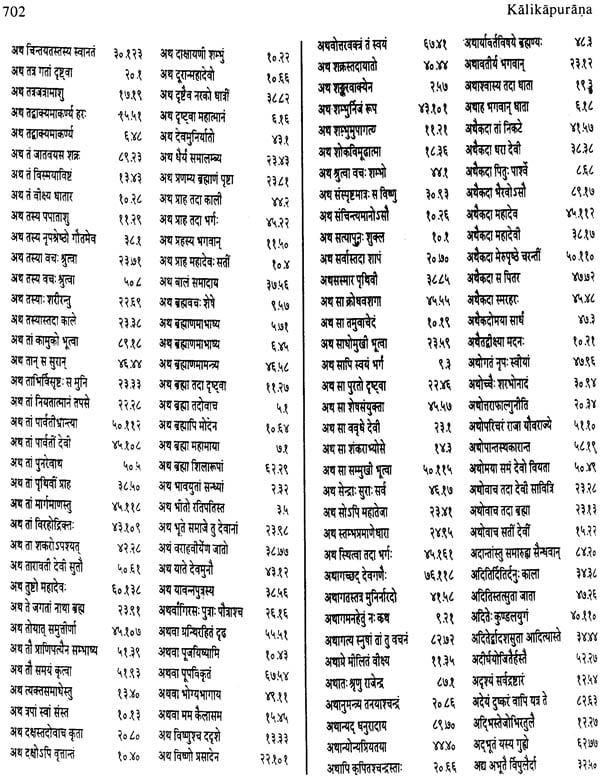
The Kalika Purana
Book Specification
| Item Code: | IDK854 |
| Author: | Prof. B.N. Shastri |
| Publisher: | Nag Publisher |
| Language: | (Sanskrit Text with English Translation) |
| Edition: | 2018 |
| ISBN: | 8170816491 |
| Pages: | 854 |
| Cover: | Hardcover |
| Other Details | 9.9" X 7.8" |
| Weight | 1.40 kg |
Book Description
1.1 In the religious tradition of India sruti (Vedas) and' smrti (what is remembered by human teachers) are the two- main branches of Sanskrit literature which are considered to be the source and authority of the age old religion. Both of them are described as the two commandments of God (sruti.smrti mamaivajne).
Manu, while declaring two more in addition to these two as the direct sources of dharma assigns the Vedas the first place, which is to be regarded as superior to all others.
Smrti in the widest acceptance of the term "includes the six vedangas, the sutras, both srauta and grhya, the law books of Manu and others, the itihasa; i.e, the Mahabharata, and the. Ramayana, the puranas, and the nitisastras,"
As the puranas come under smrti they are next only to the Vedas in their authority to dharma. The puranas are also regarded as the soul of the Vedas. (atma puranam vedanam). Both itihasa and puranas are the supplement and complement to the Vedas, and as such', the real meaning of .be Vedas is to be interpreted With the help of itiasa and purana, without the knowledge of which the meaning of the Vedas might be lost.
Historically speaking all the puranas are of later origin, i.e. latter than the Vedas, and developed on what have been adumbrated in the Vedas. Thus, 'he Puranas, in-a"Wide sense, are the elaborate commentaries on the vedic tenets. It is why itihasa and puranas are recommended for proper understand- ing the meaning of the saying of the Vedas.
However, we come across with another traditional view which holds that the puranas are older than the Vedas, .and these came out from the mouth of Brahma before the Vedas were emanated forth from him. Such an assertion, no doubt, goes against the traditionally accepted order and seems to be an anachronism. The significance of the saying may be traced in the fact that the oral tradition of the puranas is as old, or even older than the Vedas, Though the puranas were compiled in historic time the oral tradition was handed down in the society since time immemorial, which swelled with the passage of time. In fact; some puranas seem to preserve certain pre- Vedic traditions and rites.
The puranas are also regarded as the Vedas or the "fifth Veda'. The Brhadaranyakopanisad says that puranas sprang up from the remainder (ucchista) of Brahma after the destruc- of tion the Universe.
reah samani chandamsi Puranam yajusa saha ,
ucchistaj-jajnire sarve divi deva divisrtah //
The Visnu-P.3, the Vayu.P.4 and the Brahmanda.P.5 speak almost in the same tune that Vyasa produced the purana- samhita out of the materials in the form of akhyaykas, upakhyanas, gathas, and kalpajoktis (tradition handed down since time immemorial). Puranas are recognised as a branch of learning in the Brahmanas. The Satapatha.bra. speaks of giving instruction on puranas to disciples by the teacher (atha nayame'hani tan.upadisati puranam vedah 30'yamiti kimcit puranam asaksita).
The Gopatha-bra. also speaks about 'Itihasa-veda' and Puran Veda The divine origin ascribed to puranas and their placement along with the Vedas are responsible for the recog- nition of the puranas as vedangas. As such their study is regard. ed as obligatory without which a person, even though well versed in the Vedas is not considered as a skilful one'. The Puranas for the ages have been the mines not only of mytho- logy and cosmic theory of creation and destruction of the world but also the fountain head of hopes and ideals for the society, strength and inspiration of the people.
1.2. The puranas are encyclopedic in contents and exhaus- tive in treatment of subjects. They are both the documents of the socio- religious order of the contemporary society, and the philosophy of life to the people of their time and to the infuture generations. The Puranas used. to exercise tremendous in fiuence on Indian. minds through the ages all over the country, and even abroad, thus they used to serve as an unifying force. The puranas are always popular with the masses of this subcontinent because they are accessible and intelligible to one and all, became: they disseminate knowledge to the people of all strata of the. society tbrough• popular myths and legends, which directly appeal to the human heart,
It is precisely not clear when the puranas have been formed into a distinct class of literature and they have acquired.
certain characteristics as to their form. How these charac- teristics have developed? When such characteristics came to be regarded as essentials? To answer these questions the- entire Purana literature is to be studied in chronological order. There is no scope for such a study in this brief introduction to this purana.
1.3.. The puranas with their unmistakable characteristics- had been recognised as a distinct class of literature before the compilation of the well known Sanskrit lexicon, Nama- Iinganusasana by Amarasimha, who gives panca-laksana (five characteristics) as the synonym of puranam (puranam panca/aksanam ).
Ksirasvamin (11th cent. A.D,) in his commentary, Amarodghatana, on Amarakosa (lst kanda) quotes the five characteristics which a purana is to possess.
sargasca pratisargasca yamso manvaniarani ca/
vamsanucaritam caiya puranam panca-laksanam //
Presumably Ksirasvamin has taken this: verse from some purana or puranas which had been codified long before him. In eight of the aighteen puranas these five characteristics are found mentioned. The Skanda.P. while stating those five characteristics has introduced new elements such as the serial order of the puranas, extension and the destruction of the world, astronomy, etc'. H.T. Colebrooke in his edition of the Amarakosa states on pancalaksana.
"Our theogony, comprising past and future events, under five heads: tbe creation; the destructicn and the recreation of the worlds; genealogy. of gods and heroes; the reigns of Manus; and 'he transaction of their descendants".
M. Winterint his History of Indian Literature observes on this point:
“Every purana. is to have five characteristics (panca- laksana) that is to treat five subjects These five things only partly form the contents banded down to us; some contain much more than what is included in the 'five characteristics', while others scarcely touch upon these subjects, but deal with quite different things. What is significant almost all our puranas, their sectarian character, i.e. their being dedicated to some god or other, or, Visnu, is completely ignored by the old definition. (Vol. I. p.522). H.H. Wilson in the preface to his English translation of the Visnupurana (pp;. V-VI) observed thus :
"The lexicon of Amarasimha gives as a synonym of purana, 'panca-laksana' that which has five characteristics". However, Wilson goes on pointing out that non-adherence to these -characteristics by majority. of the puro11a3 and asserts that Visnu•p. alone may claim the distinction of conforming to these characteristics. "such, at any rate, were the constituent and characteristic portions of a purana in the days of Amara- simha, fifty•six years hefore the Chrisfian era, and if the puranas had undergone no change since his time, such as we expect to find them all. Do they conform to the description? Not exactly in anyone instance; to some it is utterly inapplic- able; to others it only partially applies. There is not one to which it belongs so entirely as to the Visnu.P., and it is one of the circumstances which gives to this work a more authentic character than most of its fellow can pretend".
: .
Contents
| Chapter | Page Nos. | |
| Introduction | ||
| 1. | Purana and upapurana | i |
| 2. | Kalika Purana | v |
| 3. | The name | vii |
| 4. | Printed edition | ix |
| 5. | Manuscripts | ix |
| 6. | Chapter and Chapter Division | xi |
| 7. | kalika Purana quoted by the Smrti digest writers | xii |
| 8. | Other Texts : Kalika Purana | xiii |
| 9. | The Myth of earlier Kali (Kalika- Purana) | xiv |
| 10. | Earlier Kalika Purana | xvi |
| 11. | The date and the place of origin of the Kalika Purana | xxvi |
| A SUMMARY OF THE KALIKA PURANA | xxxiv | |
| NARAKA MYTH AND PRAGJOYOTISA | lxxvii | |
| | ||
| 1. | The Birth of Kama (Cupid) | 1 |
| 2. | The Illusion of Brahma | 6 |
| 3. | The Birth of Rati | 11 |
| 4. | The Birth of Vasanta (Spring) | 16 |
| 5. | The Prayer of Mahamaya by Brahma | 20 |
| 6. | Prayer of Yognidra | 28 |
| 7. | Dialogue between Brahma and Madana | 34 |
| 8. | The Birth of Safi | 37 |
| 9. | Persuation of Hara for Marrying a wife | 44 |
| 10. | Mahadeva expresses his desire and seeks Sati | 49 |
| 11. | The Marriage procession of Siva | 56 |
| 12. | Identity of Brahma, Visnu and Mahesvara | 62 |
| 13. | Mitigation of the anger of Siva | 68 |
| 14. | Dalliance of Hara with Sati | 72 |
| 15. | Siva and Sati departure for their abode in the Himalayas | 77 |
| 16. | Siva dalliance with Sati and her death | 82 |
| 17. | The Destruction of the sacrifice of Daksa | 89 |
| 18. | Vijaya grief | 94 |
| 19. | Sandhya's preparation for penance | 105 |
| 20. | Deliverance of Chandra from the curse of Daksa | 112 |
| 21. | Candra's emancipation from the curse of Daksa | 126 |
| 22. | The birth story of Arundhanti | 138 |
| 23. | The Marriage of Vasistha with Arundhari | 148 |
| 24. | The Destruction of the world | 160 |
| 25. | The Varaha - Creation | 171 |
| 26. | The Creation of the world | 177 |
| 27. | Description of creation | 179 |
| 28. | Description of real and unreal | 184 |
| 29. | The Dialogue between Varha and Sarabha | 186 |
| 30. | The Fight between varaha and Sarabha | 190 |
| 31. | Emergence of Sacrifice from the body of Yajna - Varaha | 205 |
| 32. | Fish Incarnation | 209 |
| 33. | Fish Incarnation | 213 |
| 34. | The description of creation of the world | 219 |
| 35. | Abandonment of the Sarabha body by Isvara (Siva) | 225 |
| 36. | Removal of suffering of Prithvi | 227 |
| 37. | The birth story of Naraka | 232 |
| 38. | Anoinment of Naraka | 236 |
| 39. | Practising austerity by Naraka | 249 |
| 40. | The Story of Naraka | 257 |
| 41. | Narada carries the message | 267 |
| 42. | Burring of Kama by Mahadeva | 274 |
| 43. | Union of Kali with Hara | 289 |
| 44. | The dialogue between Kali and Hara | 298 |
| 45. | The description of Ardhanarisvara, God as half-women | 303 |
| 46. | The birth of Skanda | 317 |
| 47. | The birth of Chandrasekhara | 325 |
| 48. | The Description of the birth of Hara and Parvati as human being on the earth | 333 |
| 49. | The Story of the page Kapota and Citrangada | 339 |
| 50. | The birth story of Vetal and Bhairava | 345 |
| 51. | Emergence of Vetal and Bhairava | 357 |
| 52. | Worship of Mahamaya | 374 |
| 53. | Mahamaya-Kalpa or the procedural rites of Mahamaya | 377 |
| 54. | Ritual procedure of Mahamaya | 380 |
| 55. | Offering sacrifice of the Goddess | 385 |
| 56. | Worship of Mahamaya | 394 |
| 57. | Worship of Mahamaya Kamakhya | 401 |
| 58. | Worship of Kamakhya | 417 |
| 59. | Ceremony of Pavitraropana | 423 |
| 60. | Worship of Goddess Durga and killingof Mahisa | 431 |
| 61. | Glorification of Kamakhya | 444 |
| 62. | Kamakhya's ritual procedure | 453 |
| 63. | The Procedure of worshipping Tripura | 464 |
| 64. | The ritual procedure of worshipping Tripura | 480 |
| 65. | The ritual procedure of worshipping of goddess Sarada | 486 |
| 66. | Definition of mudras | 492 |
| 67. | The Rudhiradhyaya : description of offering bali | 501 |
| 68. | The description of offerings to the goddess | 517 |
| 69. | Description of cloths etc. For the goddess | 523 |
| 70. | The description of eatables (naivedya) | 536 |
| 71. | Circumbulation and paying obeisance | 540 |
| 72. | The glory of Kamakhya | 543 |
| 73. | Matrkanyasa i.e. placement of syllables on the body of the adept | 550 |
| 74. | Worship of three forms of Tripura | 553 |
| 75. | The mystery of Tripura mantra | 572 |
| 76. | Vetal and Bhairava attained Siddhi | 580 |
| 77. | Description of the glory of Jalpisa-pitha | 590 |
| 78. | Description of sacred places, hills and rivers of kamarupa | 593 |
| 79. | place of pilgrimage in Kamarupa | 602 |
| 80. | The description of holy rivers and places of pilgrimage of Kamarupa | 616 |
| 81. | The curse of Vasistha on Ugratara and others | 631 |
| 82. | The birth of Brahmaputra | 635 |
| 83. | The story of Rama, son of Jamadagni | 641 |
| 84. | The state polity | 645 |
| 85. | Description of good manners | 657 |
| 86. | The rules of Pusya-snana (ceremonial bath) on the day when the star pusya falls | 663 |
| 87. | The raising of Sakradhavaja | 675 |
| 88. | Visnu-Yajna | 680 |
| 89. | The emergence of Bhairava dynasty | 686 |
| 90. | Dynasty of Vetal | 697 |
| Shloka Index | 701 |
